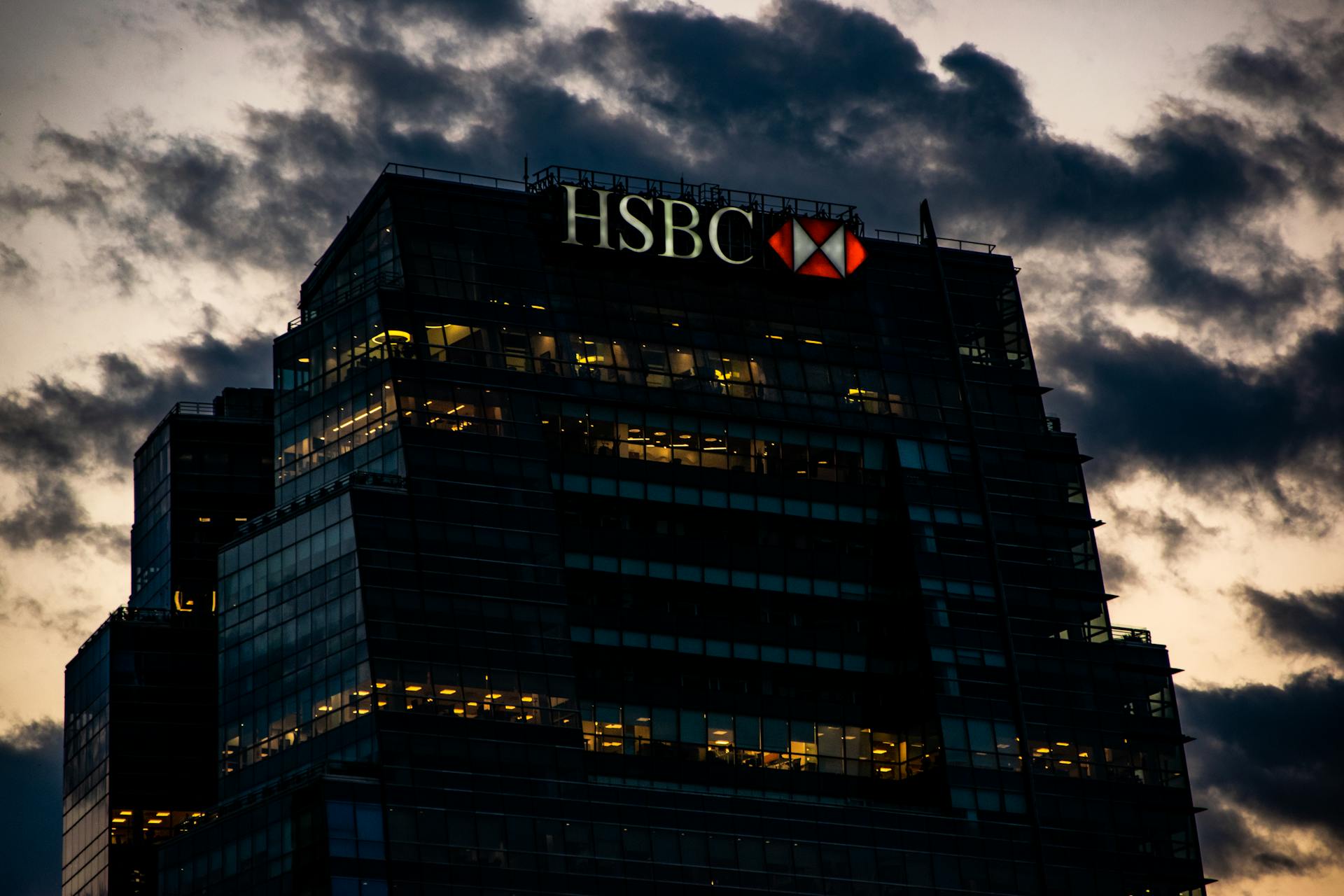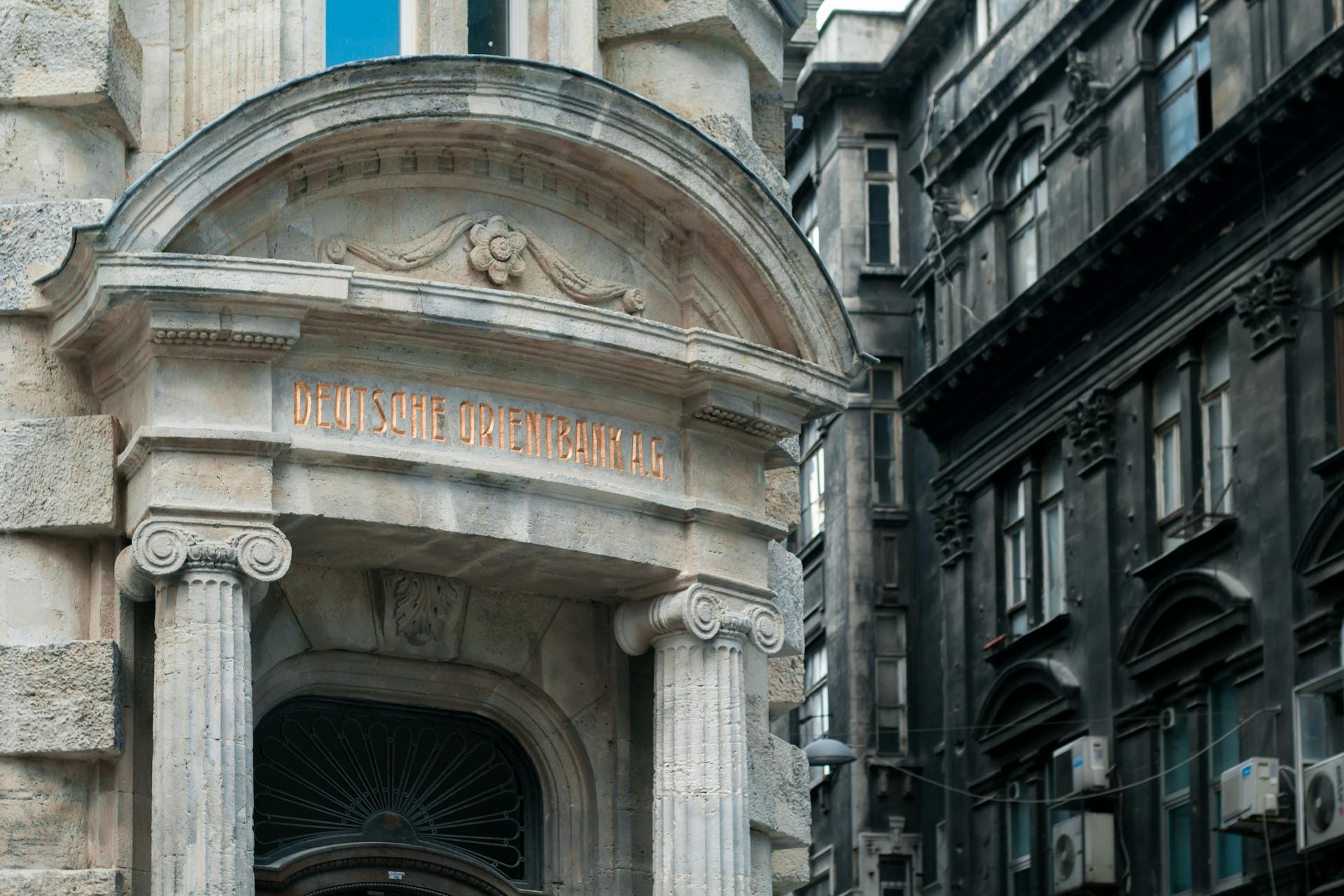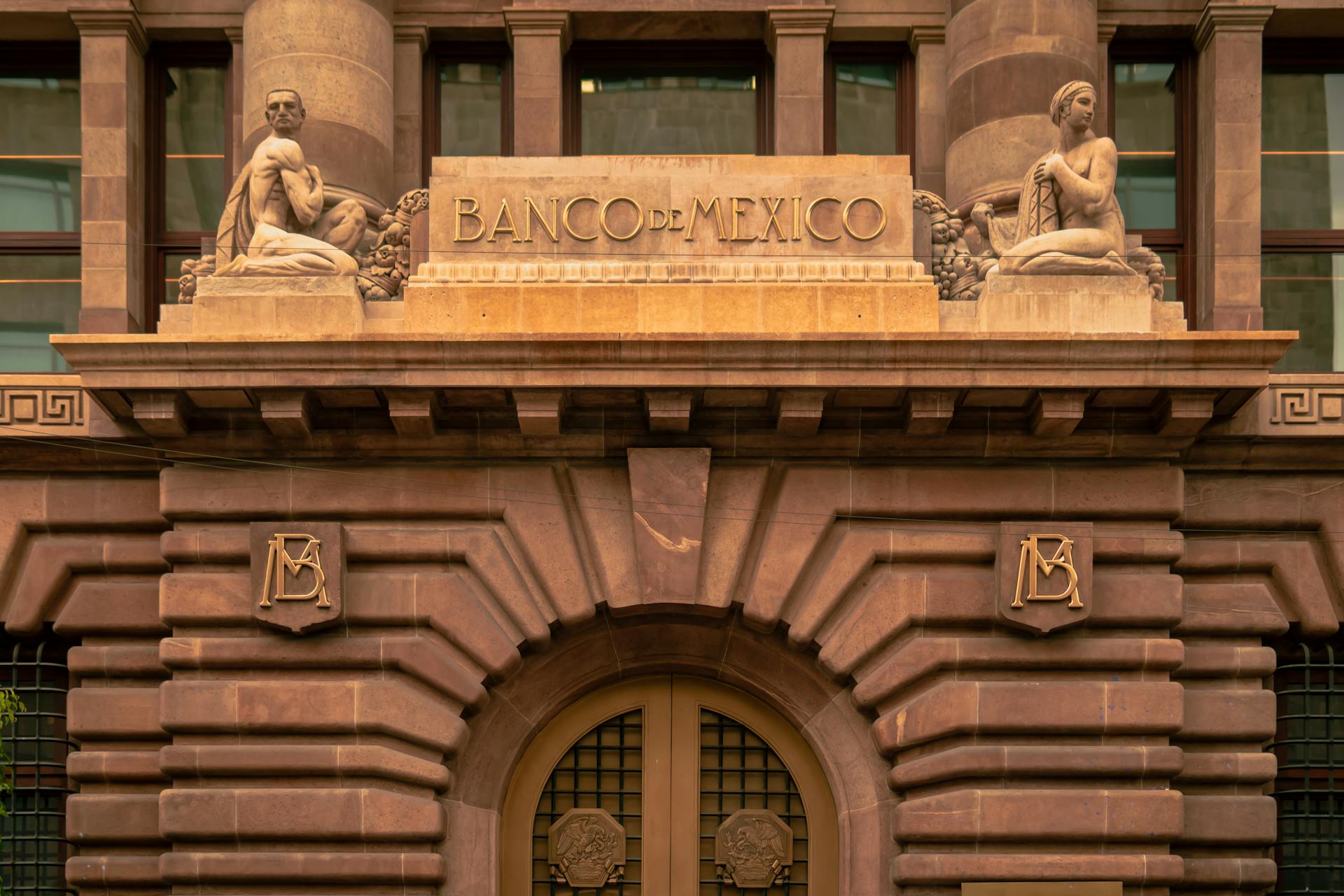
The Second National Bank was a pivotal moment in U.S. history, marking a significant shift in the country's economic landscape.
Established in 1816, the bank was created to stabilize the nation's currency and provide a safe and reliable place for people to store their money.
The bank's charter was signed into law by President James Madison, who recognized the need for a stronger banking system in the aftermath of the War of 1812.
The Second National Bank played a crucial role in financing the country's growth and development, providing loans to businesses and individuals to invest in infrastructure, agriculture, and industry.
Its impact was felt across the country, with many cities and towns experiencing rapid growth and development as a result of the bank's investments.
Establishment
The establishment of the Second National Bank was a significant event in American history, driven by the country's transformation from a simple agrarian society to one that was increasingly industrialized and financially complex. This transformation created a need for a more uniform and stable paper currency.
In 1816, Congress passed a bill creating the Second Bank of the United States, which President James Madison signed into law. The charter was signed on April 10, 1816, and it provided for a paid-in capital stock of $35 million.
The bank was a hybrid public-private corporation, with private investors subscribing to 80 percent of the shares and the U.S. Treasury owning the remaining 20 percent. This structure made the bank a unique entity that was both a for-profit commercial bank and a repository for the nation's public money.
Broaden your view: What Does the Truth in Lending Act Regulation Z Require
Origins of the U.S
The Second Bank of the United States was created in 1816 after Congress passed a bill that President James Madison signed. This new bank was a direct result of the financial instability experienced during the War of 1812.
Many merchants and financiers, including John Jacob Astor and Stephen Girard, lobbied for a new bank because they had helped raise money for the war effort. They wanted to ensure that there was a stable financial system in place.
Worth a look: New Law about Credit Cards

The charter of the Second Bank of the United States was modeled after the First Bank of the United States, which had been established in 1791. The Second Bank had a paid-in capital stock of $35 million.
The U.S. Treasury owned 20 percent of the shares, while private investors owned the remaining 80 percent. The bank's capital stock was subscribed to by private investors, who contributed $28 million.
The Second Bank of the United States played a crucial role in collecting and distributing federal money and servicing the nation's public debt. It helped to account for 20 percent of the nation's banking capital and bank lending in the form of discounts.
You might like: The History of American Banking
Establishment
The establishment of the Second Bank of the United States was a pivotal moment in American history. The charter was signed into law by James Madison on April 10, 1816.
The Era of Good Feelings, a time of national unity and cooperation, favored the development of national programs and institutions, including a protective tariff, internal improvements, and the revival of a Bank of the United States. Southern and western support for the bank, led by Republican nationalists John C. Calhoun of South Carolina and Henry Clay of Kentucky, was decisive in the successful chartering effort.
Additional reading: Bank of United States

The bank's establishment was driven by the need for a more uniform and stable paper currency, as many state-chartered banks had stopped redeeming their notes, causing financial instability. The federal government's financial position had deteriorated amid a broader economic downturn.
The Second Bank of the United States was a hybrid public-private corporation, with private investors subscribing to 80 percent of its shares and the U.S. Treasury owning the remaining 20 percent. The bank's paid-in capital stock was $35 million.
The bank's charter was the result of a long and contentious process, with many politicians and business leaders lobbying for its creation. The experience of financial instability and currency devaluation during the War of 1812 had convinced many American politicians of the utility of a central bank.
For another approach, see: Consumer Financial Protection Bureau Credit Cards
Terms of Charter
A charter is a formal document that outlines the rights and responsibilities of a company or organization.
It's a binding contract that outlines the scope of the charter, including its purpose, goals, and objectives.
The charter typically defines the authority and powers of the company or organization, including its ability to make decisions and take actions.
A charter can be issued by a government or a regulatory body, and it's often required for companies to operate legally.
In the case of a company, the charter may outline the roles and responsibilities of its directors and officers.
The charter may also specify the company's financial structure and management, including its capitalization and dividend policies.
A well-written charter can help prevent conflicts and ensure that the company is run in a fair and transparent manner.
It's essential to review and update the charter regularly to ensure it remains relevant and effective.
Curious to learn more? Check out: Bank Holding Company Act
Structure and Operations
The Second National Bank was established in 1824, making it one of the oldest banks in the United States. It was founded by a group of prominent businessmen and politicians who saw a need for a more stable financial system.
The bank's main office was located in New York City, and it had branches in several other cities across the country. Its headquarters was a grand building that reflected the bank's wealth and influence.
The bank's operations were overseen by a board of directors, which included some of the most respected business leaders of the time. These directors played a crucial role in shaping the bank's policies and making key decisions about its operations.
The bank's capital was raised through the sale of stock, which was marketed to investors across the country. This allowed the bank to raise a significant amount of capital quickly and efficiently.
The bank's assets grew rapidly in the years following its founding, thanks in part to its strategic investments in the growing industries of the time.
Leadership
The leadership of the second national bank was marked by significant changes and challenges. William Jones, the first president, had gone bankrupt before taking the position.
Jones's leadership was plagued by extending too much credit and then reversing that trend too quickly, leading to a financial panic. This resulted in a steep recession.
Langdon Cheves, a former speaker of the House of Representatives, took over as president in 1819 and implemented policies that cut the number of second Bank banknotes in circulation. He also made fewer loans and foreclosed on mortgages.
Cheves's policies sent many state-chartered financial institutions into bankruptcy because they didn't have enough gold and silver on hand to cover redemptions. This led to another depression characterized by deflation and high unemployment.
Nicholas Biddle, a member of a wealthy and prominent Philadelphia family, became head of the Bank in 1823. He had previously served on the Bank's board of directors and in the Pennsylvania legislature.
Biddle increased the number of notes issued by the Bank, which contributed significantly to economic stability and growth.
Additional reading: Routing Number for Huntington National Bank
The Battle Over
The Second National Bank was a hotly contested institution from its inception. Its first president, William Jones, was a Philadelphia merchant and politician backed by businessmen in Baltimore eager to tap the Bank's wealth.
The Bank lent aggressively to merchants and land speculators, and gave sweetheart loans secured by the Bank's own stock to Jones' associates. This led to a loss of $1.5 million in the Baltimore branch, equivalent to $21 million today.
The Bank's profligate lending weakened it, causing paper currency to depreciate at varying rates in different parts of the country. This weakened the national economy.
The Bank was forced to retrench, calling in loans and slashing circulation, which worsened the Panic of 1819. This caused widespread bank and business failures.
The Bank's actions during the Panic sowed the seeds of its later destruction. People in the west saw the Bank repossessing their livelihoods and creating "pretty permanent enemies" for the Bank.
The Bank's president, Nicholas Biddle, later recalled that it began its career as "a monied institution governed by those who had no money." This lack of oversight led to a series of questionable financial decisions.
Explore further: Huntington National Bank Sba Loans
Andrew Jackson Ends Shutdown
Andrew Jackson announced in 1833 that the government would no longer use Second Bank of the United States.
He removed all federal funds from the bank, ending the bank's operations and fulfilling his promise to the public.
The Second Bank of the United States was founded in 1816, five years after the first national bank's charter had expired.
Jackson resented the bank's lack of funding for expansion into the Western territories and its unusual political and economic power.
He called for an investigation into the bank's policies and political agenda, challenging its constitutionality.
The bank's director, Nicholas Biddle, fought back with the help of members of Congress like Kentucky Senator Henry Clay.
Jackson presented his case against the bank in a speech to Congress, but they decided the bank was constitutional.
The controversy continued for three years, leading to a split in Jackson's cabinet and a veto of a new charter for the bank.
For your interest: Payday Loan United States
Jackson's re-election campaign centered around his promise to empower the "common man" and close the bank.
He successfully removed all federal funds from the bank in 1833, redistributing them to various state banks.
The bank's charter officially expired in 1836, marking the end of the Second Bank of the United States.
Closing U.S. Bank
The Second National Bank's fate was sealed in 1834, when the House of Representatives voted against rechartering the Bank.
This decision was a major blow to the Bank's supporters, who had been unable to muster a two-thirds majority to override Jackson's veto in 1832.
The removal of federal deposits in 1833 had already reduced the Bank's size and influence over the nation's currency and credit.
The widespread defeat of the pro-Bank Whig Party in the 1834 congressional elections further solidified the Bank's demise.
It would take more than seventy-five years for the United States to make another attempt at establishing a central bank.
The U.S. economy experienced several banking crises during this period, but the Panic of 1907 ultimately led to the creation of the Federal Reserve System in 1913.
Biddle's Central Bank's Economic Role
Nicholas Biddle's Central Bank played a significant role in the nation's economy from 1816 to 1836. The Second Bank of the United States was headquartered in Philadelphia, Pennsylvania.
The Bank was involved in managing the nation's currency and credit. It was a central bank that aimed to stabilize the economy.
Under Nicholas Biddle's leadership, the Bank became a powerful institution that influenced the nation's economy. Biddle's leadership was marked by a dramatic political showdown with President Andrew Jackson.
The Bank War, as it came to be known, shaped the political, economic, and ideological contours of American life in the pre-Civil War era.
Recommended read: Avatar Nation
How the U.S. Worked
The Second Bank of the United States was a federally chartered bank that operated from 1816 to 1836.
It was established by an act of Congress in 1816, signed into law by President James Madison.
The bank's headquarters were located in Philadelphia, Pennsylvania.
Its primary goal was to stabilize the national currency and manage the public debt.
The bank was headed by a president who served a five-year term.
The bank's operations were overseen by a board of directors and a cashier.
The bank's charter was set to expire in 1836, after which it would be dissolved.
Frequently Asked Questions
What happened to Second National Bank?
The Second National Bank ceased operations after failing to secure recharter and underwent liquidation in 1841. National banks would not be reinstated until the National Bank Act was passed in 1863-1864.
What was the importance of the Second National Bank?
The Second National Bank played a crucial role in stabilizing the national currency and managing the economy's money supply, interest rates, and credit flow. By doing so, it helped maintain economic stability and control.
Sources
- https://www.federalreservehistory.org/essays/second-bank-of-the-us
- https://www.economic-historian.com/p/second-bank-of-the-united-states
- https://kids.kiddle.co/Second_Bank_of_the_United_States
- https://www.exploros.com/summary/Andrew-Jackson-shuts-down-Second-Bank-of-the-U-S
- https://www.minneapolisfed.org/article/2008/the-monster-of-chestnut-street
Featured Images: pexels.com


